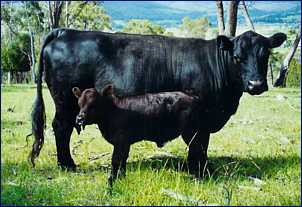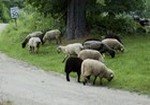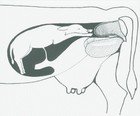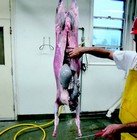Dexter Cattle - Ideal Small Cattle Breed for Homesteads and Small Farms
 Dexter
cattle are a miniature cattle breed
for
small farms and homesteads.
Dexter
cattle are a miniature cattle breed
for
small farms and homesteads.
We have information here on Dexter cows for both meat and milk and what to feed them.
Originating from Ireland more than a century ago, they are dual purpose cattle, raised for both milk and meat, and because of their size, are the ideal house cow for hobby farmers.
Dexters are also very good cattle to keep in areas that are prone to drought. Not only do they eat less than conventional breeds, but if they get less food, they just give less milk if they are being kept as milking cows.
Dexter Cattle: Size, Color and Temperament
Most Dexter cows are black in color, although a dark red or dun cow can occur from time to time. Standing at about 1 meter to the shoulder, an adult cow weighs in at 300 kilo grams. A mature bull can stand as high as 1.2 meters and can weigh more than 450 kilo grams. However, they are still considerably smaller than your conventional cattle.
The horns of the bulls usually extend directly out to each side, making a curve forward and upward, with a considerable space between the two horns. The color of the horns being usually white with black tips.
Dexter cattle temperaments vary from some being very docile to others being rather quick tempered. If they have been constantly handled by their breeders before purchase, they are usually the docile ones and easy to handle. They are excellent mothers and calve easily. They also make very good surrogate mothers and will often look after 4 or more calves at a time.
Dexters are better at foraging for their food, live long, produce well and rear about 10 calves during their lifetime. Because they are small cattle, you can stock more cattle per acre than you would with conventional cattle breeds.
Dexter will often calve until they are 18 or even 20 years old. 17-18 years, however, is the average lifespan of a dexter.
Dexter Cattle: Dexters for Milk
The beauty of owning Dexter cows is that despite their small size, their milk output matches those of full-sized cows. They can yield up to 20 liters of milk a day, although 10 liters is considered average. Butterfat levels average 4-5% with yields of cream up to 1 liters in 5; ideal for making cheese.
Dexter cattle are easy to keep as they live on grass or hay when grass is scarce. Occasionally, they can be given a little grain or concentrate pellets at milking time as in incentive, especially if you are asking them to feed a calf as well.
Cows are herd animals, and therefore, if you are going to keep cattle it is better to keep one or two others. They need plenty of water to keep up their milk production and it should be clean at all times.
Although your dexter cattle are hardy animals that could be milked outside if you wanted to, they do need shelter from extreme weather either in an open shed or byre.
The best milkers are given good pasture to feed on and this is very evident if they are allowed to feed on good herbal ley pasture grass. Having several of these for them to have access is good for worm control.
One disadvantage of Dexter milking cows is that they can have small teats which make it difficult if you are going to milk your cows by hand. However, milking machines will stay on smaller teats, and where larger teats can get scratched and bruised this won't be the case with your Dexter milking cows. Investing in an electric milking machine may well prove to be a good investment if you have several Dexter cows for milking.
Dexter Cattle: Dexters for Meat
Dexters are good beef animals, producing good quality cuts. The meat is lean and the meat to bone ratio is excellent. Another advantage is that the smaller joints make home-freezing much easier.
A 3 year old steer would reach a killing out weight of 460 kg. However, for intensive farming, which we don't support, this could be achieved in 12 months. They would reach 180 kg within 14 months which would be an acceptable weight for slaughter.With grass-fed animals the meat is tender and lean. With grain feeding it is finely marbled in the prime cuts and a lighter color. However, we do not support the feeding of cattle grain as this is an unnatural food for them.
Dexter Cattle: Feeding and Housing Dexters
Being much smaller than conventional cows they don't need as much space for pasture. A half acre of good green grass per animal, or 12 to 15 pounds of hay and a little grain each day is enough in temperate climates. They are good foragers and eat the same things as goats, and will even survive on rough pasture. However they will need good fencing, sheep fencing is good enough for Dexters. They will also need a constant supply of clean water and shelter from inclement weather. However, they are also able to live in the open in all types of weather, and TB and other diseases due to close housing are uncommon.
Conclusion:
Did you find this page helpful?
Sharing is a way of saying, "Thanks!"
Follow Us and Keep Up to Date
Add your Own Comments on Dexters here!
Do you own Dexters? Tell us what you think about this breed. Perhaps you own another small breed of livestock that you think is better. We would love to here your comments. It's really easy, just type below and press submit. Your submission will appear once it has been approved.
Leave a Comment
Do you have anything that you would like to add after reading this page? We would love to hear your thoughts. If you can add additional information to what has been written here you will be adding value to the website! No need to have any special skills - just type and submit. We will do the rest!
Other Comments
Click below to see comments from other visitors to this page...
One of my two dexter momma's gave birth yesterday. 




This is my first experience with cows calving. I bought two bred dexters last fall and one 5 month old. I'm so happy that I chose dexter's.
Lucky for …
raising alpaca and dexter cattle together 




I would like to bring up,from young, 2 dexters with an alpaca.
Has anyone done that before and can give me any feedback on this?
What to Feed Cattle 



Hi,
After much ado, like chasing a calf through bean fields for 3 days, I now have 2 Dexter's. 1 heifer and 1 bull calf.
I'm trying to work out …









New! Comments
Do you have something of value to add? Leave me a comment in the box below.